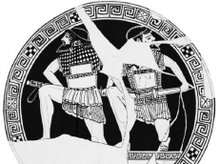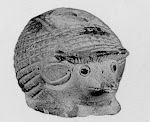It has long been a goal of mine to assist groups of reenactors in generating quantitative data on various aspects of hoplite combat. This would be hard data, numbers that we could crunch to provide a true comparison between individuals and between hoplite reenactment groups.
There are many elements of hoplite combat that need to be tested, but my main concern is the safety of reenactors, thus no othismos for the time being. I've attached an image that could serve as a first attempt at a standardized test for hoplite groups. This set-up is a basic stabbing test. The data will give us a rate of striking for a hoplite in formation. I think this rate can be fairly well correlated to the offensive potential of hoplites engaged in doratismos. By altering the size of the target and requiring more accuracy, we can simulate strikes that would "kill" or wound. Because we are simulating group combat, at least three men side by side are needed to create a hoplite bounded on both flanks by other men. For our purposes only the central hoplite can be have his strike number recorded, for only he in flanked by others.

Within this basic set-up, we can alter a variety of variables:
Duration of test period: stamina
Size of target (moving target): accuracy
Grip type: underhand or overhand
Number of ranks in the phalanx
Lateral inter-hoplite spacing
Fore-and-aft spacing
Number of ranks stabbing forward at targets (1, 2 or 3)
Striking while under physical pressure from rear ranks of various length files
Change focus to record the striking rate of the second or third man in the file
Here is a second simple test. This one is to quantify the loss of cohesion that we all know occurs as a phalanx advances rapidly in close order. You simply measure the distance between a point on any adjacent hoplites in rank or file- I suggest the left foot. Then you have the formation advance at whatever speed and in whatever formation you wish to test. The men are made to stop at some signal, a horn or simple shout is preferable to a demarkation so that it is harder to predict. Then you simply remeasure the distances between hoplites. The deviation between each pair from their original spacing is a measure of a loss of order. From there you can ask if they became tighter or looser. The test can be repeated varying the with different starting formations, individual advancing posture, distance, and speed of advance, etc.

I've got a few groups signed on for some testing and welcome any who seek to join. Whatever we are able to do I will run appropriate statistics on and we'll try to publish someplace so that we can all refer to it. Obviously a large number of individuals being tested is good to control for variation between hoplites, but I'd like to get multiple groups involved as well if possible. I welcome discussion on this experiment and hopefully we can plan other experiments as well.





5 comments:
I will post comment concerning whole hoplite combat here as this is your latest message on this topic.
First of all thank you...For years this hoplite combat seemed very overlooked and oddly presented part of ancient battles..Charge directly into othismos, and othismos only don't hold ground for a while now...Your texts on phases of combat literary opened my eyes.Physics explanation etc ...trully excelent work.
I would only ask how long do you tink othismos lasted compared to doratismos and other phases,like with fighting on even closer range - swords, broken, spears shields, wrestling etc?
My view is it could not last very long,especialy if trained and untrained groups are faced...and I think much of the praise individual hoplites received is for their actions in doratismos,and fighting in very close range with anything they got (all before othismos)..because honestly I dont think how can one excell that much in close othismos compared to others, to receve praise...
To add to previous comment...
I see on your illustrations as well as in people reenacting that most when using this high position of spear,or underhand grip tend to grip it as in pottery images (shown right in picture I will provide),which is pretty unreliable,clumsy and simply can not put enough force,even if you manage to hit anything smaller than cow..
As for aim it is because we miss 6th finger to stabilize the spear from lower side of the smallest finger,and because of that hole such long object as spear influenced by gravity falls down,aim is poor,and it gets worse with more length of object(spear moving few mm near hand will move few tens of cm at spear point, 1 m in front), and spear is almost uncontrolable in that way, and i find hard even holding spear in such way..and seeing reenactors do that I confirm exactly that, clumsy "dancing" of spears, and they can not even hit anything let alone pierce with force..And the fact is they don't try to hit anything because they don't do hitting and battle...
And also changing to attack below hip means we have to throw and quickly grip overhand as spear falls..In battle?? Come on...
Why don't anyone use far more obvious grip,as shown in picture left..Pack a lot more punch (i pierced wood,and even broken my 3cm diameter spear,that is how much force is put),It is because such attack includes deltoid muscles as well as upper back and lat (and the pottery attack only uses triceps/biceps action)...Is superbly stable and easely to aim...And changing to lower attack is just bringing arm down,as simple as that..
http://www.uploadgeek.com/share-AAD1_4C9B9D2A.html
http://www.uploadgeek.com/share-AAD1_4C9B9D2A.html
"Your texts on phases of combat literary opened my eyes.Physics explanation etc ...trully excelent work."
Thanks, that is the reaction I like to receive! I thank you for your input.
"I would only ask how long do you tink othismos lasted compared to doratismos and other phases,like with fighting on even closer range - swords, broken, spears shields, wrestling etc?"
Based on a crowd model it could last very long. Just like a crowd at a rock concert can pack very tight and exert enough force to break steel retaining barriers, then loosen up again, othismos may have gone through phases of packing and unpacking as men became fatigued. Just like weary wrestlers who pull apart as if by mutual consent, then could simply both stop pushing and the crowd would loosen, perhaps even pull apart completely. Then they could renew again and start the cycle all over again.
"I think much of the praise individual hoplites received is for their actions in doratismos,and fighting in very close range with anything they got (all before othismos)..because honestly I dont think how can one excell that much in close othismos compared to others, to receve praise"
Perhaps the strongest feature of my model is that it allows for doratismos for an extended period prior to othismos, and surely this would be the time for individual acts of valor to be seen. But it is possible that the vicious in-fighting by men in othismos could produce such acts of valor. For example, killing a few men in the file ahead of you, men you are face to face with, would surely be noted by those around you and destabilize the enemy.
Continued:
"I see on your illustrations as well as in people reenacting that most when using this high position of spear,or underhand grip tend to grip it as in pottery images (shown right in picture I will provide),which is pretty unreliable,clumsy and simply can not put enough force,even if you manage to hit anything smaller than cow.."
This is one of those instances where individual experience comes in. A number of studies on striking overhand and underhand have shown that overhand (high) strike generate substantially more force than an underhand strike. This has to do with the major muscle groups involved and the range of motion. This becomes apparent when you consider that we throw overhand with much more force than underhand. As to accuracy, I am at least as accurate with the overhand grips as I am with an underhand strike. I can repeatedly hit a tennis ball on a string with force for example, which is probably not as good as a truly trained hoplite. And that is with an 8’, rear weighted dory, so about 5’ extends in front of my hand. I can only say that this is a matter of practice, but you also need to make sure that your dory is not too heavy and properly balanced at the point you are gripping it.
"And also changing to attack below hip means we have to throw and quickly grip overhand as spear falls..In battle?? Come on..."
This is not a problem, because myself and some reenactors have hit upon what is almost surely the proper way to bring the dory to bear. In short, you never hold it underhand and do not charge with it low. There is a way to easily bring the dory from rest on your shoulder to the overhand strike position. I’ll post some video.
"Why don't anyone use far more obvious grip,as shown in picture left..Pack a lot more punch (i pierced wood,and even broken my 3cm diameter spear,that is how much force is put),It is because such attack includes deltoid muscles as well as upper back and lat (and the pottery attack only uses triceps/biceps action)...Is superbly stable and easely to aim...And changing to lower attack is just bringing arm down,as simple as that.."
The grip you are describing is what I and others call “high underhand”. It is surely the postion from which swords are used to stab as seen in many images. I can be used to strike, but it is not a stronger strike than overhand. What you are describing, the use of just the arm in overhand striking, is simply a “jab” with the dory. A full strike involves all of the muscles engaged in the high underhand strike, but the geometry of the arm ensures that they are used to better mechanical advantage and over a longer range of motion. The high underhand strike is essentially a punch, while the overhand strike is more akin to a throwing motion without the end release.
You can see how difficult it can be to compare the experiences of different people. You have prompted me to do a long post on strikes and stances as well as my promised review of Mathew’s paper.
Post a Comment